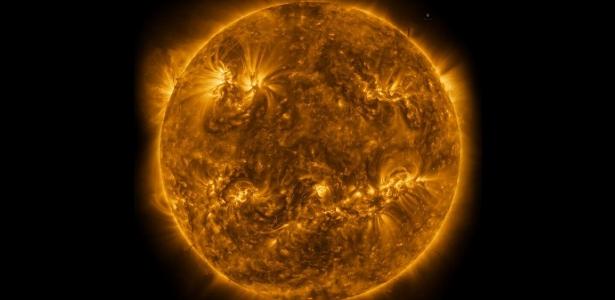New images of the Sun with a resolution of 83 million pixels made by the Solar Orbiter probe show several unprecedented details of the star, such as its atmosphere and the solar disk.
With this information, scientists will be able to delineate the eruptions that occur from the solar corona to the innermost atmospheric layers. What’s more, the images could help unravel a decades-old mystery: what causes the solar corona to reach one million degrees Celsius, while the surface temperature is just 5,000 degrees Celsius?
A mosaic of 25 images
According to ESA (European Space Agency), the images were captured on March 7 when the spacecraft was about 75 million kilometers away from the Sun. Although it seems a lot, this distance is equivalent to half the distance between the Earth and the Sun and the closest that a photographic equipment has ever managed to get to the star.
Due to the proximity, it was necessary to capture 25 images, which together form a mosaic, and reproduce the entire Sun.
One of the photos was captured by a device called the Extreme Ultraviolet Imager (EUI) and, according to ESA, the image is considered to be the highest resolution ever taken of the entire solar disk and the corona, the outermost atmosphere.
“The EUI High Resolution Telescope takes pictures at such a high spatial resolution that, at this distance, a mosaic of 25 individual images is required to cover the entire Sun. Photographed one after the other, the complete image was captured in a period of more than four hours because [o registro de] each part of the mosaic takes about 10 minutes, including the time for the spacecraft to position itself from one segment to the next,” ESA wrote in a statement.
The resolution of 83 million pixels provides ten times more clarity than a television with 4K technology can reproduce.
Another Solar Orbiter instrument used to capture the image was the Spice (Spectral Imaging of the Coronal Environment), which makes it possible to analyze more deeply the Sun going from the corona to the atmosphere.
With it, it was possible to produce an image of the Sun in a wavelength of ultraviolet light, emitted by gaseous hydrogen. And just as with the photos captured by the EUI, it was also necessary to stitch together the Spice images into a mosaic.
The sequence of images captured by this equipment presents different colors, which, according to ESA, shows the temperatures of various elements. Gaseous hydrogen (purple) at 10,000 °C, carbon (blue) at 32,000 °C, oxygen (green) at 320,000 °C and neon (yellow) at 630,000 °C.
While scientists on Earth continue to investigate the Sun’s never-before-seen details, the Solar Orbiter probe continues to operate and approach the Sun. Tomorrow (26), it will be at its closest point to the Sun during its trajectory.
Solar Orbiter launched in February 2020 and has since been used to collect data and images of the Sun.
*With information: European Space Agency (ESA)
–


